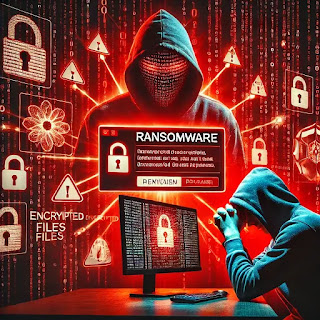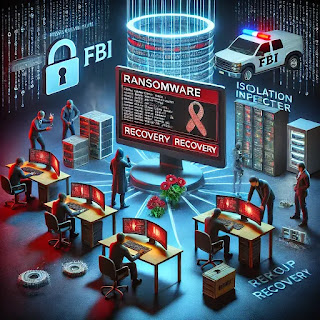Ransomware Attacks: Prevention, Detection, and Recovery Strategies.
In today’s digital age,
ransomware attacks have become one of the most pervasive and damaging cyber
threats. Imagine waking up one morning to find all your critical files
encrypted, with a ominous message demanding payment in cryptocurrency to regain
access. This nightmare scenario has become a reality for countless individuals,
businesses, and even governments. Ransomware is no longer just a buzzword—it’s
a clear and present danger. But don’t panic just yet. With the right knowledge
and strategies, you can protect yourself, detect threats early, and recover
effectively if the worst happens. Let’s dive into the world of ransomware,
breaking down how it works, how to prevent it, and what to do if you’re hit.
What is Ransomware, and Why Should You Care?
Ransomware is a type of malicious
software (malware) designed to block access to a computer system or data until
a ransom is paid. It typically encrypts files, making them unreadable, and
demands payment—often in Bitcoin or other cryptocurrencies—to restore access.
Some variants go a step further, threatening to leak sensitive data if the
ransom isn’t paid, adding a layer of extortion to the attack.
The impact of ransomware is
staggering. According to a 2023 report by Cybersecurity Ventures, global
ransomware damages are predicted to reach $30 billion annually by 2031.
High-profile attacks, like the Colonial Pipeline incident in 2021, have
disrupted critical infrastructure, causing fuel shortages and highlighting the
far-reaching consequences of these attacks. But it’s not just large
organizations at risk. Small businesses, schools, hospitals, and even
individuals are increasingly targeted.
How Ransomware Works: The Anatomy of an Attack?
To defend against ransomware,
it’s essential to understand how it operates. Most ransomware attacks follow a
similar playbook:
·
Infiltration:
The attacker gains access to a system, often through phishing emails,
malicious attachments, or exploiting vulnerabilities in software. For example,
the WannaCry ransomware in 2017 exploited a vulnerability in Microsoft Windows,
infecting hundreds of thousands of computers worldwide.
·
Execution:
Once inside, the malware encrypts files, rendering them inaccessible. The
attacker then displays a ransom note, usually with instructions on how to pay.
·
Extortion:
Victims are pressured to pay quickly, often with threats of permanent data loss
or public exposure of sensitive information.
·
Profit: If
the ransom is paid, the attacker may provide a decryption key—though there’s no
guarantee. Many victims never regain access to their data, even after paying.
Prevention:
Your First Line of Defense
The best way to deal with
ransomware is to prevent it from happening in the first place. Here are some
proven strategies:
1. Educate and Train
Employees
Human error is one of the most common entry points for ransomware. Phishing emails, for instance, rely on tricking users into clicking malicious links or downloading infected attachments. Regular training sessions can help employees recognize and avoid these threats.
2. Keep Software
Updated
Outdated software is a goldmine
for cybercriminals. Ensure all systems, applications, and devices are running
the latest versions with security patches applied. The WannaCry attack, for
example, exploited a vulnerability for which a patch had already been
released—but many organizations hadn’t updated their systems.
3. Implement Strong
Access Controls
Limit user access to only the
data and systems they need to perform their jobs. This reduces the risk of
ransomware spreading across your network if one account is compromised.
4. Backup, Backup,
Backup
Regularly back up your data and
store it offline or in a secure cloud environment. This ensures that even if
your files are encrypted, you can restore them without paying the ransom. The
3-2-1 rule is a good guideline: keep three copies of your data, on two
different types of media, with one stored offsite.
5. Use Advanced
Security Tools
Invest in robust antivirus
software, firewalls, and intrusion detection systems. Endpoint detection and
response (EDR) solutions can also help identify and block ransomware before it
causes damage.
Detection: Spotting the Warning Signs
Even with strong prevention
measures, it’s crucial to detect ransomware early to minimize damage. Here’s
what to look for:
·
Unusual
File Activity: Rapid encryption or renaming of files is a red flag.
·
Strange
Network Traffic: Spikes in data transfers or communication with unknown servers
could indicate an attack.
·
Ransom
Notes: If you see a message demanding payment, it’s already too late to
prevent the attack—but early detection can still limit its spread.
Advanced monitoring tools, such
as Security Information and Event Management (SIEM) systems, can help identify
these signs in real time.
Recovery: What to Do If You’re Hit
Despite your best efforts,
ransomware can still slip through. If you’re attacked, here’s how to respond:
1. Isolate the
Infection
Immediately disconnect infected
devices from the network to prevent the ransomware from spreading. This might
mean shutting down systems or disconnecting them from Wi-Fi.
2. Assess the Damage
Determine which files and systems
are affected. Check your backups to ensure they’re intact and not compromised.
3. Report the
Incident
Notify law enforcement and relevant authorities. In the U.S., for example, you can report ransomware attacks to the FBI’s Internet Crime Complaint Center (IC3).
4. Decide Whether to
Pay the Ransom
This is a tough call. While
paying might seem like the quickest way to regain access, it’s not guaranteed
to work—and it fuels the ransomware economy. Many experts advise against paying
unless absolutely necessary.
5. Restore from
Backups
If you have clean, up-to-date
backups, use them to restore your systems. This is why regular backups are so
critical.
6. Learn from the
Incident
Conduct a post-incident review to
identify what went wrong and how to improve your defenses. This might involve
updating policies, investing in new tools, or providing additional training.
Real-World Lessons: Case Studies
·
Colonial
Pipeline (2021)
One of the most infamous ransomware attacks, the Colonial Pipeline incident, disrupted fuel supplies across the U.S. East Coast. The company paid a $4.4 million ransom but still faced significant operational and reputational damage. The attack underscored the importance of securing critical infrastructure and having a robust incident response plan.
·
Maersk
(2017)
Shipping giant
Maersk fell victim to the NotPetya ransomware, which caused an estimated $300
million in losses. The company had to reinstall 4,000 servers and 45,000 PCs
from scratch. Maersk’s recovery highlighted the value of comprehensive backups
and the need for resilience in the face of cyberattacks.
Conclusion: Staying One Step Ahead
Ransomware is a formidable
threat, but it’s not unbeatable. By understanding how these attacks work,
implementing strong prevention measures, and having a clear recovery plan, you
can significantly reduce your risk. Remember, cybersecurity is not a one-time
effort—it’s an ongoing process that requires vigilance, education, and
adaptation.
As the saying goes, “An ounce of prevention is worth a pound of cure.” In the case of ransomware, that ounce could save you millions of dollars, countless hours, and immeasurable stress. Stay informed, stay prepared, and don’t let the cybercriminals win.






